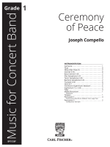Concert band Bass Clarinet, Bass Drum, Bassoon, Bb Euphonium, Clarinet in Bb 1, Clarinet in Bb 2, Crash Cymbals, Euphonium, Flute, Horn, Oboe, Percussion 1, Percussion 2, Piccolo, Snare Drum, Suspended Cymbal, Timpani, Trombone, Trumpet in Bb 1 and more. - Grade 2
SKU: CF.YPS268
An Adventure in Tritones. Composed by Joseph Compello. Folio. Score and parts. 241 pages. Duration 4 minutes, 53 seconds. Carl Fischer Music #YPS268. Published by Carl Fischer Music (CF.YPS268).
ISBN 9781491165904. UPC: 680160924950. 9 x 12 inches. Key: C minor.
The tritone was once considered an ugly sounding interval. So ugly, in fact, that it was referred to as diablos in musica. Consequently, many composers for centuries have used the sound of the tritone to musically depict something sinister. A famous example is in the introduction to Saint-Saëns' Danse Macabre where the notes A and Eb are bowed simultaneously on a retuned violin. My humble contribution to this category of compositions is Doctor Tritonicus. He is a character of my own imagination inspired by the genre of villainous comic book characters whose names are frequently preceded by the title of doctor. The following is a formal description of the music interspersed with comic book elements which students may find entertaining:Doctor Tritonicus makes his formidable entrance in mm. 1–19 as tritones are heard in fortissimo bass instruments. At m. 20 the tritone persists quietly, yet ponderously, in the bass line as the clarinets state a marcato theme in C minor. A crescendo at m. 39 leads to a forceful repeat of the previous material; this time with the chimes ("Hell's Bells") reinforcing the bass line. A brass fanfare at m. 56 features tritone progressions as the woodwinds and xylophone answer with tritone figurations of their own. A new countermelody of tritone-laden intervals at m. 78 ornaments the first C-minor tune heard earlier. At m. 99 Doctor Tritonicus opines that he is not entirely sinister. Here the saxes, woodwinds, and horns perform a lyrical melody over a bass line of tritones. The first portion of the lyrical section (mm 99–118) harmonically spans a tritone chord progression from C minor to F# minor. The second section (mm. 118-138) inverts the tritone progression from F# minor to the C minor recapitulation at m. 138. Once again Doctor Tritonicus displays his sinister character in a faster and more agitated tempo with "Hell's Bells" reinforcing the tritone bass line. The Coda at m. 196 desperately hammers the sinister tritone sound until the a comic book hero descends from the sky (mm. 208–209) to resolve the tritone with the sound of a victorious C-major chord. .









































